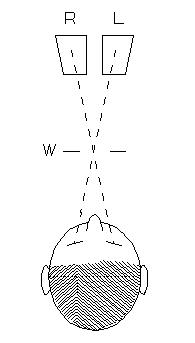
Gallery 2 of Stereo Pictures for Cross-Eyed Viewing.
Introduction.
These galleries presume some prior knowledge of stereo photography. Those new to this form of photography can get a painless tutorial at Life & Depth: An Introduction to Stereo Photography.These pages require a monitor width of at least 1000 pixels in order to see both images for cross-eyed stereo viewing. Since the photos also have large vertical dimension, it helps to toggle the "full screen" view (F11 in Windows). However, if you haven't mastered that viewing method, these pictures may also be appreciated as 2d flat photos. All are © 2008 by Donald Simanek.
For instructions on free-viewing 3d by the cross eyed method, see the How to View 3D page.
Many of these are experimental photos, not perfect, but indicative of what can be done with homebult close-up 3d cameras, hand-held 3d using the shifty ("Cha-cha") method, and pictures taken from the air, using the plane's motion to give the parallax shift.
The Gallery.
Bumblebee, taken with the bugshooter1 camera on Ektachrome.
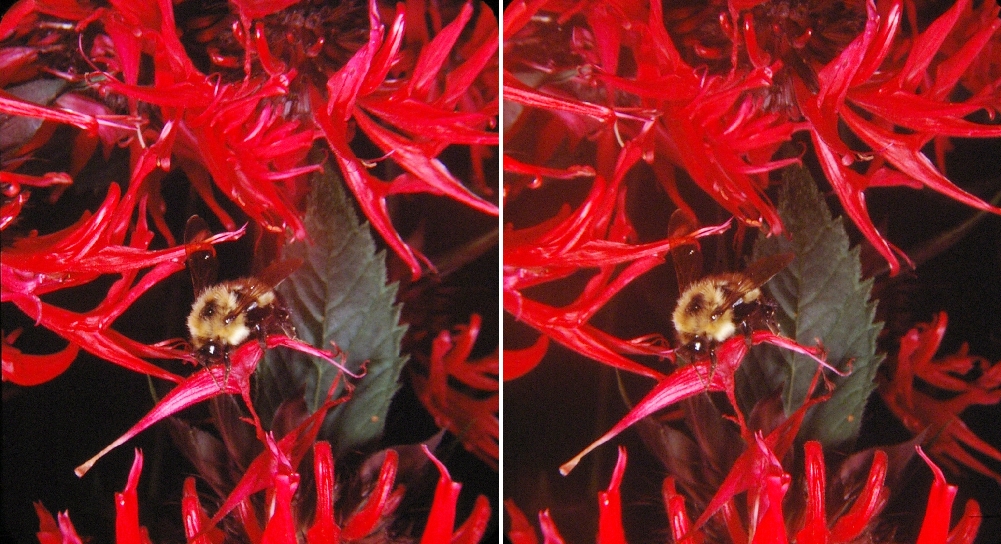
There's a honeybee in this picture. Actually two of them.

The bee in the last picture was almost lost in the greenery. Here's an example of how much cropping you can get away with even in an old stereo taken on film.

Honeybee at work.

Another honeybee.

For scenics and travel photography, the stereo cameras of the 1950s were ideal. Certain models are still eagerly sought for those who do film photography. Among the best were the Realists, Kodak, and the French Verascope, which had a wider format. Pictured here is the Revere camera.

Deadwood in the Colorado National Monument, Summer, 1971. Verascope camera with Kodachrome.
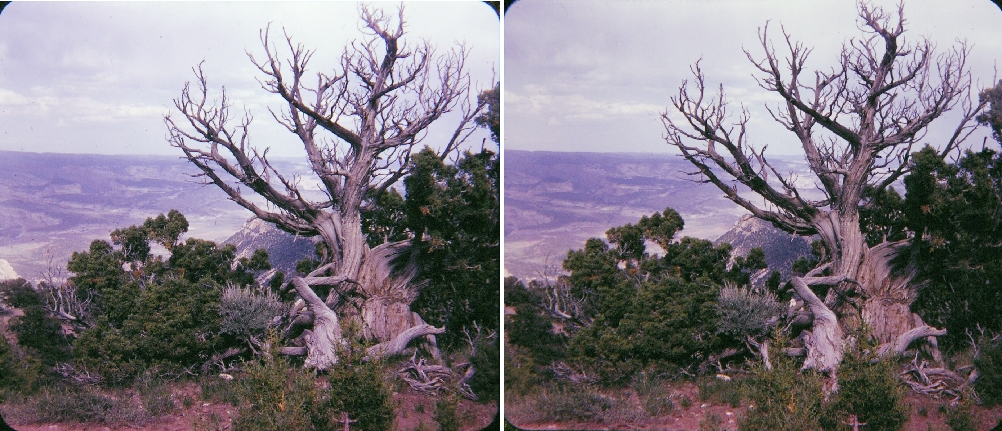
The same scene as Ansel Adams might have liked it. The blue record was removed from the color picture, then it was rendered in black and white, with boosted gamma and contrast.
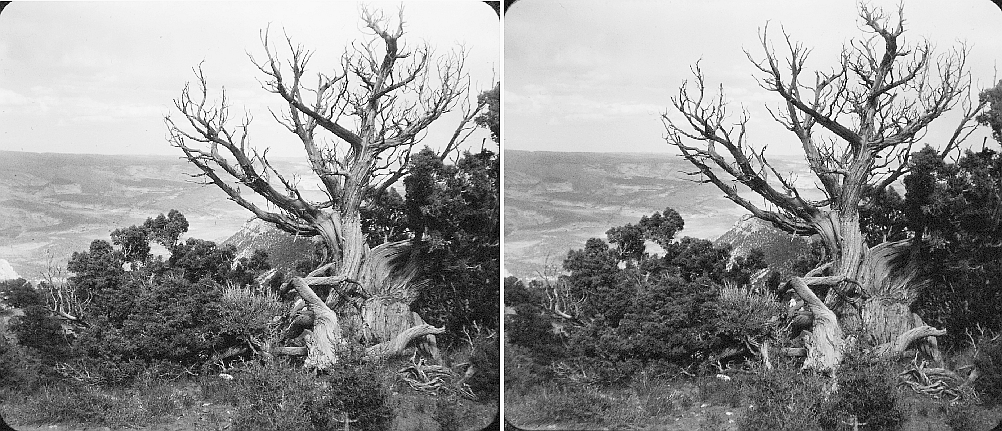
Riverside geyser at Yellowstone National Park, Sept, 1971. Verascope stereo camera with Kodachrome.
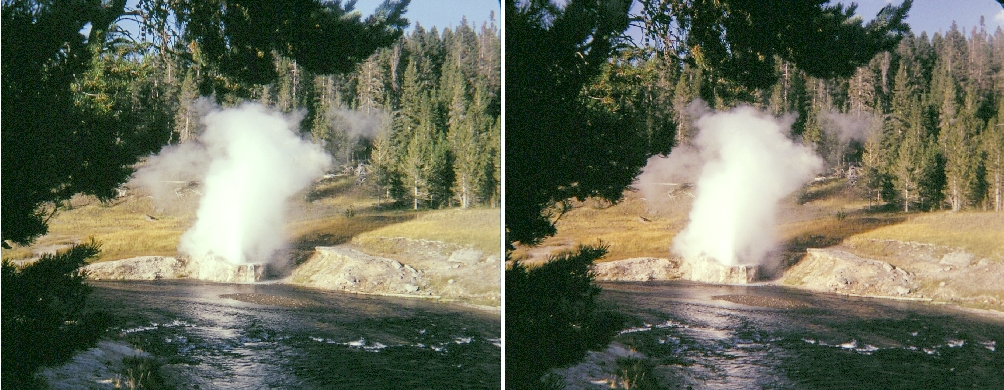
Tulips in early May, 2008. Hand-held digital camera.

Appendix.
One of the important characteristics of a stereo photograph is the horizontal angle of view. If it is too small, the picture seems "cramped" and the sensation is of "looking down a tunnel". On the other hand, excessive "wide-angle" stereos have a different sort of artificial feel to them. When we view a scene in nature, the peripheral areas of vision have negligible stereo depth. Here's some data and calculations:
| Camera | Lens focal length | Film or Sensor Size | Horizontal angle |
|---|---|---|---|
| 35mm film 8 sprocket width | 34mm (wideangle) 50 mm (normal) 105mm (telephoto) | 24 x 36 mm | 55.8° 39.5° 19.5° |
| European 3d format 7 sprocket | 40 mm | 24 x 29.5 mm | 40.5° |
| Realist stereo 5 sprocket | 35 mm | 24 x 23 mm | 36.4° |
| Half frame 4 sprocket | 50 mm | 24 x 18 mm | 20° |
| Nimslo 4 sprocket (half frame). | 30 mm | 22 x 18 mm | 33° |
| 90° rotation devices. Tri-Delta with 35mm film. | 50 mm | 18 x 24 mm | 27° |
| Sub-frame digital SLR. 4:3 sensor. | 55mm 38 mm 18mm | 15.7 x 23.5 mm | 24.1° 34.4° 66.3° |
| Half sub-frame, Loreo 3d Digital Lens-in-a-Cap. | 38mm | 5.9 x 15.7 mm | 16.7° |
| Half sub-frame, Loreo 3D Digital Lens-in-a-Cap with 0.7x wideangle adapters. | 38mm | 5.9 x 15.7 mm | 23.8° |
| Half sub-frame, Loreo 9008* 3D Digital Lens in a Cap. | 25mm | 5.9 x 15.7 mm | 25.4° |
| Fuji FinePix REAL 3D W1 | 6.3 - 18.9 mm (35 - 105mm equiv.**) | 4.62 x 6.16 mm (1/2.3" ***) | 18.5° - 67.4° |
* The Loreo 9008 Digital Lens in a Cap was announced for sale in mid 2008. On July 14, 2009, after a year of delays, Loreo announced that due to production problems the product was being withdrawn. Apparently none were ever sold, though a few were loaned to beta testers.
** Focal length of lens of a 35mm film camera which would give equivalent results.
*** The archaic designation of sensor sizes. For an explanation, see sensor sizes.
Ortho Stereo.
Stereo photographers refer to "ortho stereo" as the condition in which the stereo picture is taken and viewed so that (1) The camera's stereo base matches that of the eyes, and (2) The viewed picture subtends the same visual angle as the camera saw and recorded. This ensures that distance and depth relations of the scene are faithfully reproduced. Let's state, for the record, that few people have ever viewed stereo under ortho-stereo conditions. Consider the popular "Realist" format which recorded a field of 36° horizontally. When projected on a screen, a viewer would have to sit a distance of 2/3 the screen width to see the picture as the camera saw it. Very few people ever sit that close. The "standard" hand held stereo viewers generally had lenses of at least 45 mm focal length. They should have had lenses matched to the camera, 35 mm, for realistic reproduction. This is the dirty little secret of stereo photography. Even worse was the popular View Master format, which always made pictures look as if seen through a tunnel.
Stereo photography systems are a collection of compromises. We probably should be content if the results "look pleasing" with sufficient depth to give a feeling of solidity, but not so great as to cause visual discomfort. After all, flat pictures, and 2d movies aren't seen with correctly reproduced scale either. If a movie were presented entirely faithfully, the use of wide angle and telephoto lenses would not be allowed. Artistic and other conditions often triumph over faithful reproduction. Note that when you use a pair of binoculars or a stereo microscope, you are also altering distance and depth. Even IMAX giant screen movies, though they have the capability of more exact reproduction of nature, seldom do, and freely employ camera lenses of varying focal lengths for dramatic effect. Worse yet, to reap more ticket sales, movies filmed for curved-dome theaters are often shown on flat screens and vice versa. Hollywood movies filmed for flat wide screens are blown up to larger size on dome Omnimax screens, and everything at the sides of the screen is unnaturally distorted for all except those patrons sitting at the geometric center of the theater. I've seen such crummy presentations showing to packed houses, and theater managers tell me they get very few complaints. (And they don't refund admission prices, so beware if you care about movies faithful to nature, and faithful to the director's intent.)
Therefore I don't apologize for the fact that my stereo close-up photography devices produce "unfaithful" rendering of depth, and the cross-eyed viewing method alters absolute depth. If the pictures "look good" I'm satisfied. The main "flaw" is that depth differences are smaller than in nature, but this makes them more comfortable to view. Also, any presentation of stereo in a book or computer screen forces the eyes to focus at a near distance, while recreating a scene that may have been at a much greater distance. This is certain to cause the brain to sense that it is not perceiving the real scene, but a replica of that scene, recreating shapes, color, texture and depth, but not entirely faithfully. And close-up photography of small subjects necessarily gives results that the naked eyes could never see, whatever method is used.
All pictures on this page © 2008 by Donald E. Simanek.
More cross-eyed stereos in 3d Gallery One.
Stereo view cards in 3d Gallery Three.
Building a digital stereo close-up photography system in 3d Gallery Four.
Review of the Loreo stereo attachment 3d Gallery Five.
Review of the Loreo macro adapter, 3d Gallery Five B
The Loreo stereo attachment—improved 3d Gallery Five C.
The Loreo LIAC attachment as a 3d macro device, 3d Gallery Five D.
Wildlife photography in your backyard, 3d Gallery Six.
A home-built digital stereo camera using mirrors 3d Gallery Seven.
Stereo close-up photography in your garden 3d Gallery Eight.
Stereo photography in your aquarium 3d Gallery Nine.
Stereo digital infrared photography 3d Gallery Ten.
Wider angle stereo with the Loreo LIAC 3d Gallery ll. A failed experiment.
Review of the Fuji FinePix Real 3D W1 camera 3d Gallery 12.
Macrophotography with the Fuji 3D camera. 3d Gallery13.
Panoramic stereo photography. 3d Gallery 14.
Tips for stereo photography with the Fuji 3d camera. 3d Gallery 15.
Mirror methods for stereo photography. 3d gallery 16.
The Fuji 3d macro adapter using mirrors, by Paul Turvill.
The Fuji 3d macro adapter with flash! 3d gallery 17.
Critters in stereo. 3d gallery 18
Wide angle stereo. 3d gallery 19.
Telephoto Stereo. 3d gallery 20.
2D to 3d Conversion. 3d gallery 21.
Stereos from outer space. 3d gallery 22.
Review of the Panasonic Lumix 3d digital camera. 3d gallery 23.
Reverberant flash for shadowless lighting.
Shifty methods for taking stereo pictures.
Digital stereo photography tricks and effects.
Stereoscopy with two synchronized cameras by Mike Andrus.
Guidelines for Stereo Composition.
![]()
Input and suggestions are welcome at the address shown to the right.
Return to the the 3d and illusions page.
Return to Donald Simanek's front page.